In 2024 five regional Enviroschools networks were supported through the final year of a 3-year partnership between Toimata with Te Uru Rākau NZ Forest Service One Billion Trees. This contributed to a range of engagement: action at the school/community level through the distribution of native trees and, tools to support planting efforts, supporting ECE and schools with WaiRestoration projects, riparian planting and rejuvenation of existing or damaged ngahere, and a focus on accessibility to ngahere for learning and play.
Te Taitokerau/Northland – riparian restoration and re-plenishing native planting
A focus in Northland has been on supporting ECE and schools with WaiRestoration projects.
Springbank School, Harvest School, BestStart Pipiwai Kindergarten and BestStart Pipiwai Road have undertaken projects that support riparian planting and care, inviting parents and whānau and the wider communities to working bees.
The BestStart Kindergartens incorporated water testing workshops where they are able to show tamariki the water quality and explain to their tamariki the importance of clean water for wildlife to flourish. A Matariki celebration brought tamariki and whānau together to plant along the neighbouring stream
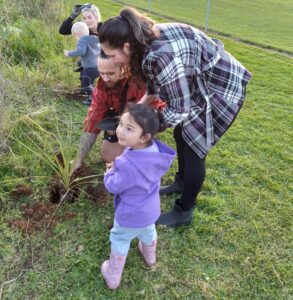
Learning and taking action together along the awa on Pipiwai Road.
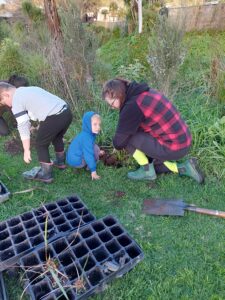
BestStart Pipiwai tamariki and whānau plant along their stream.
Springbank School embraces pre-school through to secondary. The school shared that, after senior students from their marine biology class undertook water quality testing with students from the junior school, there was the desire from students to plant riparian zones to improve the health of the stream. The resulting project focused on planting along 25m of the waterway. Additionally, the 1BT funding supported development of a native garden area that links the two sections of the school – the Headstart (Yr 0-1) and the rest of the Junior School. This area is a shared space between the different learning entities.
Harvest Christian School wanted to ensure that swales and riparian zones in their new school were planted to reduce erosion and improve habitat for native wildlife. They cleared invasive weeds and planted over 200m of pond and riparian zone (see banner image).
“The planting projects were an important learning experience for the school students. During the working bee we discussed the importance of planting waterways, we discussed how gorse can be a valuable nurse plant and we taught species identification and good planting techniques. As a school we hope that by involving the children in planting, they will feel a connection to the land and feel inspired to care for it. We hope to transform our riparian zones into areas where native bush and wildlife thrive”. – Harvest Christian School
Waikato – Rejuvenating ngahere in schools
Waikato again offered grant funding to schools to enable biodiversity projects.

Under-planting and improving access were 2 of the focuses at Otaua School.
Students at Otaua School rejuvenated the much-loved forest area of their school to make it more accessible as an outdoor learning space. The makeover saw the clearing of pest plants, pruning broken/dead branches from existing trees, maintenance of structures in the forest, and over 150 new plants planted. Students are excited about being able to collect seeds and propagate seedlings for ongoing use in the forest space or sharing with our community, as well as learning more about native plant species and the natural progression of the seasons. Right: Students clear broken branches in the school forest area.
At Opoutere School, the cyclones in 2023 resulted in significant losses of the native trees in the school including some of the largest and oldest native trees. It had also seen invasive species take over. Students took the lead in managing a rejuvenation project as they wanted to see their ngahere healthy for future students to enjoy. The project was school wide, with the youngest learners connecting with pūrākau/ traditional stories to strengthen their connections to the ngahere. Older tamariki researched appropriate trees and suppliers, consulting with local hapū on the growing history of the area, what they know grows best, and what they wish for the area to look like. This was incorporated into a planting concept plan. 130 trees were planted, and students are monitoring what is successfully growing and any increase in bird life and the reduction of weeds and pests
You can read more about this Opoutere story: Enviroschools | Honouring Papatūānuku through tree-planting project
Taranaki – supporting planting in ECE and schools
Taranaki focused supporting action at the school/community level through the distribution of native trees and tools to support planting efforts.
19 ECE and schools undertook planting projects for future biodiversity, to provide shade and shelter, to build outdoor classroom areas, or to tackle erosion and wet areas. 800 plants were distributed across the region, and schools were further supported with tools, potting mix, PB planter bags, and Jiffy pots for eco-sourced seed growing.
3 Enviro Action Days were held and attended by 230 students from 10 schools. Students learnt about plant identification, planting techniques, eco-sourcing of natives, how to read the age of a tree and what it went through in its life, and preferences of birds and insects
Te Tairāwhiti/Gisborne –focus on riparian planting
Te Tairāwhiti/Gisborne supported the development of school/ community-based nurseries and assisted with planting projects with a focus on riparian planting.
In Te Tairāwhiti, the Women’s Native Tree Project Trust (WNTPT) has a community nursery that classes visit and learn about how to seed collect and grow native trees. Over 350 students across eight schools visited the WNTP nursery to learn how to grow native trees. This included seed collecting, seed processing, weeding and selecting the right plants for their school planting. Approximately 17,000 native trees were planted across different schools in Gisborne:
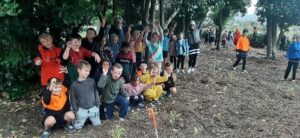
The ngahere at Makauri School receives some love and care.
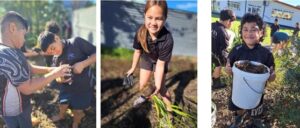
Kaita School getting the mahi done.
180 students at Makauri School planted 275 native plants at their school. The planting was to supplement a very degraded area with existing canopy species. Students extended the area, cleared the privet and gave the whole area a much-needed mulching to bring it back to life. This was great community planting with lots of whānau dropping in with cardboard, spades, post hole borers and energy.
250 students at Kaiti School planted 147 native plants over a two-day blitz – there was a focus on wet tolerant species as the planting area is prone to being flooded. The entire school got involved with mulching all of the trees with carboard and mulch. Students also made some ephemeral art from their older plantings
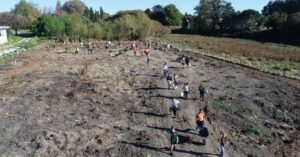
Campion College students in the area prepared for planting.
A focus on riparian planting saw Campion College work with Haumanu Tu Ora, Mahaki Mahinga Kai and Te Ngahuru Tikotikoiere to look after urban streams. This included planting over 1,400 plants at Campion College, and a further 15,000 wetland plants along the esplanade.
For all of these Tairāwhiti tree plantings, schools worked with WNTPT, who supported with advice and supply of plants. Planting work was also supported by Eastland Port, who donated and delivered mulch.
Otago – propagating native trees and enhancing school grounds
Ōtākou/Otago had two focus areas – funding for school planting projects (as in previous years) and a project with three schools to develop propagation knowledge so students are capable of propagating native plants on a scale they can sell to their communities.
Otago has two focus areas – funding for school planting projects (as in previous years) and a project with three schools to develop propagation knowledge so students are capable of propagating native plants on a scale they can sell to their communities.
Waitaki Boys High School – a long-term project to bring life back to the creek that runsthrough the school. 100 native plants were planted across 30m on both sides of thecreek.

Tarras students and sedges ready for planting.

Sowing the seeds of restoration.
Students at Tarras and Omakau Schools have been working with Haehaeata Trust to learn how to propagate eco-sourced native trees, which are to be grown in new school green houses and planted on school grounds. Both schools have plans to redesign and reforest areas of the schools to attract more native wildlife.
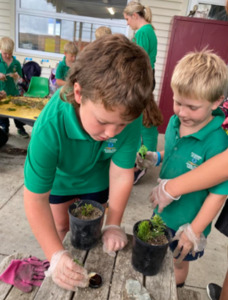
Poolburn students learn from facilitators Lucy and Rachael about the different species and how to grow them.
Students at Poolburn School have also been using their new green house to learn about propagation and have been collecting seed from local stream catchments to grow eco- sourced trees for planting at their school and in the local community. They are excited about supporting the work of the local Poolburn Catchment Group, which is working towards enhancing biodiversity in the Ida Valley by restoring native flora and fauna to riparian margins.
Waikouaiti School has been involved in the restoration of Hawkesbury Lagoon, which has been building on their understanding of the ecosystem of the lagoon. The lagoon is part of the school’s local area, and is used as an extension to their classrooms. In conjunction with the Hawkesbury Lagoon trust, students planted 70 plants with plant guards.
Fenwick School, St. Leonards Primary School, Green Island Primary School and Maheno School have been creating native plant areas to enhance biodiversity of the flora and fauna within their respective school grounds. Students have been planning and preparing areas ready for planting and over 230 plants have been planted across the schools.

Pausing to reflect and celebrate the mahi.

Fenwick students dig in to make a difference.
This brings to a close this 3 years of collaboration and funding. You can read more about the benefits of this in the reflective article here.